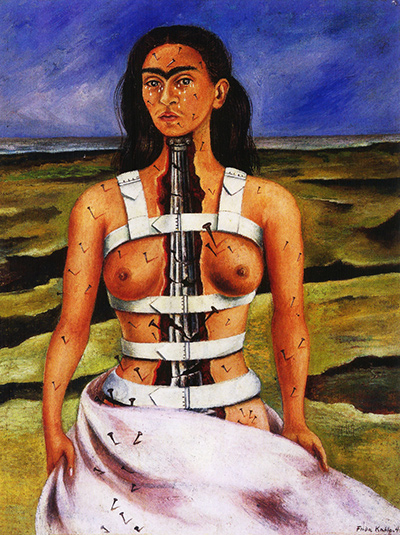This topic continued and intensified dramatically towards the end of her life as her own health deteriorated. Graphic depictions of herself experiencing torment are a stark insight into her own struggles against physical adversity and pain. The Broken Column, painted in 1944, is a work Kahlo produced a short while after undergoing spinal surgery. This was just one of many medical procedures she endured during her lifetime to correct problems that were the result of her earlier accident. At the time of painting Kahlo was required to wear a steel corset as oppose to the plaster casts she had previously worn.
In the painting Kahlo sets herself against a bleak and fractured landscape that appears to have undergone as much upheaval and trauma as the artist. She has a deep and jagged fissure along the length of her near-naked torso allowing the viewer to see her spine shown as a cracked and ruptured Ionic stone column. Her spinal column looks close to collapse particularly at the base. Nails of various sizes pierce her entire body and face adding to her suffering. Tears run freely and copiously down her cheeks.
Kahlo originally painted herself nude apart from the banded medical support corset she wears but later added a white surgical-looking sheet to cover her lower half. Her breasts are exposed and despite her body being mutilated her sensuality is still obviously apparent. There are also strong echoes of Christian iconic martyrdom in the depiction of nails and sheets. In spite of the agony being experienced there is a look of strength and defiance in Kahlo's face. Even though her body is injured and tortured it is apparent that her spirit is still intact.
The symbolic elements to this painting attempt to portray the artist as entirely alone, accompanied only by the pain and torment of her injuries. Other self-portraits have shown her protected by nature or friendship, but her the background is barren and she stands alone, with a sombre expression. It is believed that this period in her life was impacted by the affairs of her husband, fellow artist Diego Rivera. This larger-than-life character seemed incapable of remaining loyal to Frida, despite their clear deep-rooted love for each other. This emotional damage arrived on top of her existing physical issues which resulted from significant problems in her childhood as well as a serious injury in around 1925, whilst travelling on a bus.
It is believed that the nails found in this scene refer to Frida being damaged emotionally by her husband. "Estar clavado" in Mexican Spanish refers to this, essentially translating as being nailed, or cheated on. We also find tears coming from her eyes which again points to this mental pain on top of the obvious physical struggles that had dogged the artist throughout her life. Could Kahlo have produced such extraordinary, expressive art without the problems that she had experienced during her lifetime? Perhaps not. Art such as this is inspired by serious incidents which drive emotions, and just having the technical ability alone would not be enough to produce a series of paintings such as this.
The Broken Column is one of the most memorable self portraits by this artist, someone who made use of this genre more that any other famous artist that we can remember, other than perhaps Rembrandt who used it to keep his finances above water. Looking beyond just this painting, you might also study other highlights such as Two Fridas, My Birth and Frieda and Diego Rivera. Each of these individual compositions help us to build a stronger picture about Frida Kahlo's personality and opinions on her life. Her oeuvre is like a diary of her life, expressing anguish, emotion and sometimes hope for the future.
A final symbolic element to this composition is the loin cloth that Frida holds to cover, perhaps protect, her lower regions. It is as if she is telling us that this is all she has left to give, after the turmoil that she has been through. She offers the viewer the opportunity to decide her fate, if you like. It is a truly vulnerable position to be in, and can't help but charm the viewer, and make them feel great sympathy and love for this incredible woman who has been particularly hard done by. Many of her troubles were purely the result of bad luck, but the pain suffered from her husband's infidelity could have been avoided and also sums up the difficulties faced by many women over the past few centuries. Such were the times, this scandal did little to ruin the reputation of her husband, whilst the modern era would probably take a different reaction to the affairs of Diego Rivera.
The Broken Column is considered by many to be Frida Kahlo's most important painting. It is hard to imagine any scene that better captures her internal and external turmoil, whilst also providing the reasons for that. In turn, this has become one of the most researched and analysed artwork from her career and it remains one of the true highlights of the impressive collection of the Museo Dolores Olmedo Patino in Mexico City. The original painting is sized at 40cm tall by 30.7cm wide and is oil on canvas mounted on Masonite. At a time when female rights and opportunities are particularly relevant, the life of such an icon as Frida Kahlo will come under even closer scrutiny. Indeed, you will find her face appearing on billboards and in the written media more now than ever - it is as if her legacy her only just started to leave its influence.


